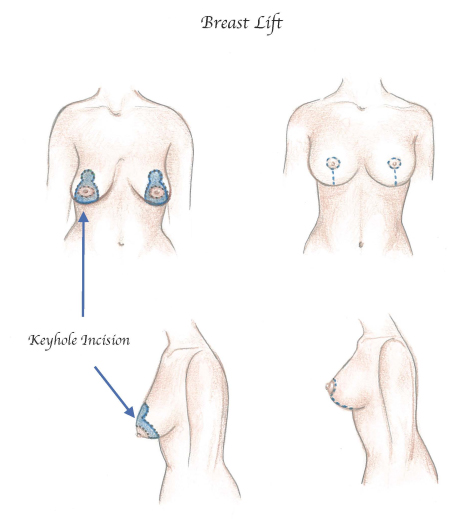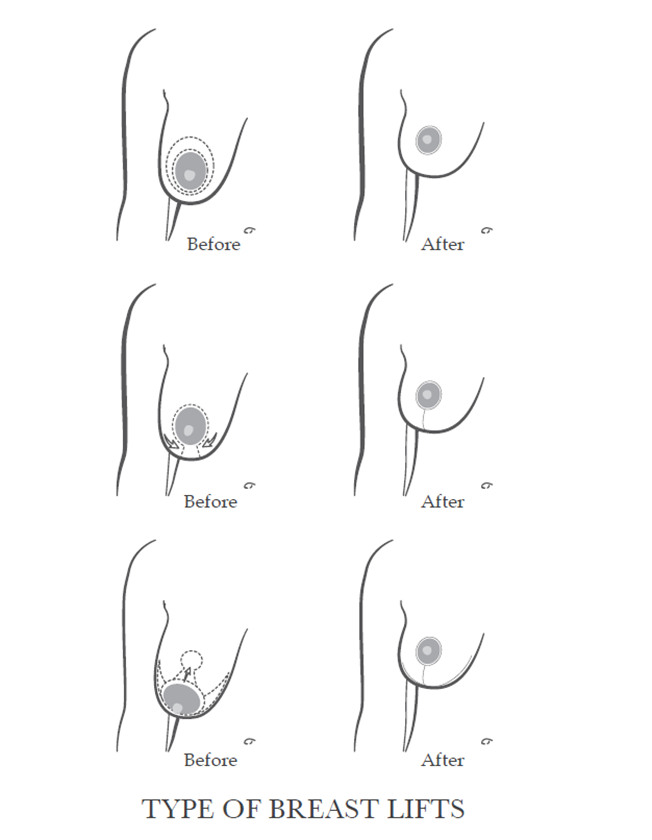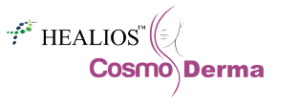A Breast Lift is designed to leave your breasts firmer and uplifted, with the position of your areolae (the darker skin surrounding the nipples) and nipples enhanced. When performing Breast Lift surgery (with or without Breast Augmentation) one should understand the aesthetics of a beautiful, youthful breast and aims to carefully incorporate these features into your results.
The typical characteristics of youthful breasts are:
The most attractive breasts, as studied by Plastic Surgeons, have the nipple approximately above this fold.
The two nipples should form an equilateral triangle with the notch above the sternum (that is, the distances between the nipples and from each nipple to the notch should all be the same.)
Breast size is proportionate to chest width, waist size and height.
Breasts are pert rather than sagging.
Breasts appear symmetrical (but are never perfectly symmetrical in any women).
Proper projection: on profile, the nipple should sit directly behind the part of the breast that projects the fullest.
Pregnancy, nursing, gravity and time can all take their toll on your breasts. If you feel like your breasts are sagging and you want them to go back to where they used to be, you might be an ideal candidate for a breast lift – also called a mastopexy.
What is a Breast Lift?
A breast lift is a surgical procedure that raises and reshapes sagging or deflated-looking breasts.
Considerations
Pros
You will have improved breast shape, projection, and symmetry
Your breasts will have a more youthful appearance.
You will look better in and out of clothes and feel more self-confident.
Cons
The effects of a breast lift might slowly diminish over time because of gravity and aging.
A breast lift leaves scars that will be hidden in a bra or swimsuit.
Subsequent pregnancy may compromise your surgical results.
Are you a good candidate for a breast lift?
If you’ve become increasingly unhappy about the sagging of your breasts, you may wonder what surgery can do. Don’t be surprised if your surgeon suggests combining breast augmentation or breast reduction with your lift; adjunct procedures may be necessary to achieve your goals.
The following are some common reasons why you may want to consider a breast lift:
Breasts that are pendulous but adequate in size.
Breasts that lack substance or firmness.
Nipples and areolas that point downward, especially if they are positioned below the breast crease.
Breasts that appear different from each other; one breast may appear firm and well positioned while the other does not.
Breasts that are not equal in size.
Breasts that are relatively small.
Breasts that are large and heavy can be lifted, but the results may not be as long-lasting as a breast lift performed on smaller breasts; the weight of larger breasts works against surgical changes.
You are finished with childbearing and breast-feeding. If you plan to have children, you may want to postpone cosmetic breast surgery. Pregnancy may stretch the breasts and reduce their volume, compromising surgery benefits.
If you are in good general health, have a positive attitude and realistic expectations, you are most likely a good candidate for this procedure.
A breast lift can help elevate loose, sagging breasts, while also improving shape, fullness and your confidence.
Detailed Procedural Info
How is a breast lift procedure performed?
A breast lift is performed under general anesthesia or intravenous sedation in an accredited hospital or surgeon’s office equipped with a surgical suite. Different techniques for removing breast skin and reshaping the breast determine the location of the incisions and resulting scars. Your surgeon will select a technique based on your breast size and shape, areola size and position, degree of breast sagging, skin quality and elasticity and how much extra skin you have.
- Your plastic surgeon will remove excess breast skin and shift the nipple and areola to a higher position.
- If your areola has become stretched, it can now be reduced in size.
- Skin that was formerly located above the areola is brought down and together, beneath the breast, to reshape the breast.
- Your surgeon will remove excess skin and close your incisions, tightening the skin, sewing the breast back together and placing sutures deep in the breast tissue to support the new breast position for a longer period of time.
- Scars are usually hidden under the breasts, although some light scarring may be seen on top of the breast.
- The nipples and areolas remain attached to underlying mounds of tissue, and this usually allows for the preservation of sensation and the ability to breast-feed.
- In some patients, it may be possible to avoid the horizontal incision beneath the breast as well as the vertical incision that runs from the bottom edge of the areola to the breast crease. If you are a good candidate for a modified technique, your plastic surgeon will discuss this with you.
What are my options?
Here is a description of the different incision patterns and techniques that your plastic surgeon will choose from:
- The “anchor” incision, made around the perimeter of the areola, vertically down from the areola to the breast crease and horizontally along the breast crease, produces the most scarring. It is for women with a severe degree of sagging who will not be helped sufficiently by less invasive techniques. This incision, which is the oldest technique, is often used for a breast lift in conjunction with a breast reduction.
- The “lollipop” lift, also known as a “keyhole” incision, made around the perimeter of the areola and vertically down from the areola to the breast crease, is suitable for women with a moderate degree of sagging who will not be helped sufficiently by the periareolar technique and who do not want breast implants.
- The “donut” lift, also known as the “periareolar incision,” made around the perimeter of the areola only, is suitable for women with a mild-to-moderate degree of sagging. When used by a skilled surgeon in conjunction with the placement of implants, it can produce a satisfactory result for patients with more pronounced sagging.
- The “crescent” lift, which is less commonly used, is an incision that lies just along the upper half of the areola. A crescent-shaped piece of skin is removed above that line, and the surrounding skin is reattached to the areola. This type of lift is usually done in conjunction with breast augmentation in women with minor sagging. It cannot accomplish the same degree of lifting as the other incision techniques.
- The “scarless” lift. For a select few women concerned more about volume loss than actual sagging, there are procedures to lift the appearance of the breast that are touted as scarless.
Incisions follow your breasts’ natural contour defining the area of excision and the new location for the nipple.
These procedures can be combined with breast implants, Thermage, Smart Lipo and/or Quill Threads to lift the breasts with minimal scarring. However, they all require incisions of some sort, no matter how small or well-hidden. These procedures are suitable for patients with very little sagging; they will not accomplish the same amount of lifting as techniques that use larger incisions.
What will my breast lift incisions and scars be like?
These vary according to the type of incision your aesthetic surgeon suggests for you. Your surgeon can conceal some incision lines in natural breast contours, but others will be visible on the breast surface.
A common method of lifting the breasts involves three incisions:
Around the aureolas
Extending downward from the areolas to the breast creases
Horizontally along the breast creases
Although incision lines are permanent, in most cases they will fade and significantly improve over time. Aesthetic plastic surgeons make every effort to place scars in hidden areas and minimize them, with the goal of achieving the desired results with the shortest possible scar. Special tissue handling and suture techniques further minimize scars.
Breast Lift Surgery Complications and Risks
Although the risk of complications are to be expected with any surgery, the more complex the procedure, the greater the risk. General risks and complications that apply to any surgery include adverse effects of anesthetic, bleeding and infection.
Infection – If an infection occurs, the symptoms usually become apparent 3 days after surgery. Signs of infection may include redness, severe swelling, wound discharge, an unpleasant smell, a burning sensation, discomfort or pain, and/or fever. To minimize the risk of infection you will be given antibiotics before and after surgery, and continue to take antibiotic medication for a few days afterwards.
Blood Loss – In the unlikely event that post-operative bleeding occurs, it may require surgical intervention. For several weeks prior to surgery, all patients are instructed not to take any anti-coagulant medications or supplements (e.g., aspirin-containing medications or vitamin E and garlic supplements).
Hematoma and Seroma – These are collections of fluid or clotted blood within a body cavity (or space) that can cause pain, scar tissue and infection, and may require surgical intervention. A patient should immediately report any sudden changes in the contour or color of their skin to the clinic.
Temporary Loss of Sensitivity or Numbness – Sensation changes in the breast area are common, but normally resolve within the first few months after surgery. Permanent sensation loss in the areola (nipple) or breasts can occur, but is extremely rare.
Scarring Irregularities – With any surgery there is a risk of hypertrophic scarring (red, raised scars), keloids (an overgrowth of scar tissue around the original incision), or inner scar tissue. Smoking or a history of abnormal scar (or collagen) formation will increase the risk of irregular scarring. A regimen of Steri-Strips directly after surgery, followed by silicone gels and sheets after suture removal, may be helpful in correcting or avoiding this problem.
Wound Separation (Dehiscence) – Women who smoke or are diabetic may be at an increased risk of their wound edges separating post-operatively. If this occurs, the wound area must be kept extremely clean. Revision surgeries are usually not necessary, but the healing process will take longer in a patient with wound separation than in a patient with normal wound healing.
Breast Asymmetry – In very rare cases, complications can lead to an asymmetrical appearance of the breasts. If appropriate, revision surgery will be required for an optimal result.
Hyperpigmentations or Permanent Bruising – Dark spots from bruising can occur, but normally fade in a matter of weeks after surgery. In rare cases,a dark spot may take longer to disappear, or even be permanent and require treatment. The simple application of warm compresses after all healing is complete can assist in the reabsorption of the blood in a dark spot; if unsuccessful, Intense Pulsed Light treatment can be used.
Fat and Tissue Necrosis – Necrosis (death of living cells) of breast fat, tissue or skin through a lack of blood supply is very rare. If an area of tissue becomes necrotic, immediate treatment is necessary to remove the affected tissue before it spreads and develops a serious infection. Patients who have a compromised wound healing ability, a history of smoking, circulatory problems, diabetes, and/or who have received radioactive/chemotherapy treatment, have an increased risk of necrosis developing.

 099006 19622
099006 19622





 Join Us On Facebook
Join Us On Facebook Join Us On Twitter
Join Us On Twitter Join Us On In.com
Join Us On In.com Subscribe to Our Blog
Subscribe to Our Blog